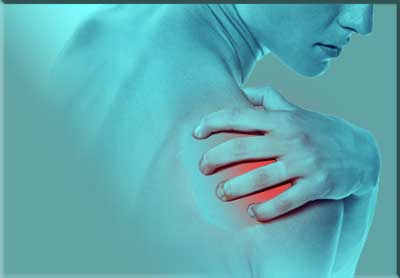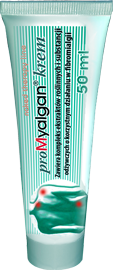
This product provides TRYPTOPHAN only and there is no taurine in contrary to Myalgan.
TRYPTOPHAN
Structural formula of a tryptophan molecule.
Notice an aromatic indolic chain.

l-tryptophan is an amino acid. Amino acids are protein building bricks. Tryptophan is also raw material (precursor) for some hormones and biologically active substances. It is important for the development and functioning of many organs in the body.
Tryptophan has a stereometric polar molecule. It can be left-rotated "l" - levo/left - meaning it is levo-rotated molecule. And it can be "d" – dextro/right - meaning it is dextro-rotated molecule. The body uses "levo" stereometric tryptophan for serotonin and melatonin syntheses. d-Tryptophan, "dextro" stereometric tryptophan molecule is fare much less utilised in the body.
L-tryptophan is called an "essential" amino acid because the body can't make it. It must be acquired from food like a vitamin. After absorbing L-tryptophan from food, our body converts it to 5-HTP (5-hyrdoxytryptophan), and then to serotonin, melatonin, and niacin (nicotinic acid or vitamin B3).
Body requirement for tryptophan
The exact daily requirement for tryptophan is unknown. The body requirement for tryptophan decreases with age. It is estimated that adults need approximately 5 mg//1 kg of body mass. Woman of 60 kg of body mass needs approx. 300 mg and man of 80 kg of body mass needs approx. 400 mg tryptophan a day. Babies and small children need tryptophan more than adults approx. 10 – 15 mg/1 kg of body mass.
The average daily diet usually covers the basic metabolic needs for tryptophan. However, quite often does not ensures optimal levels of serotonin. It is because tryptophan is the least plentiful from all of 20 protein building amino acids. Our diet provides approximately 1 gram of tryptophan only and in the body is a constant fight competing for its limited quantity. Tryptophan supplementation, even in small quantities, ensures higher serotonin levels in central nervous system because it may help in more efficient competition for transport through blood-brain barrier. Tryptophan competes for this transport with other amino acids.
Our body uses tryptophan for building up various protein structures. People who have small or limited niacin (vitamin PP) quantities in diet the body can form this vitamin from niacin in the liver. However, 1 milligram of niacin from 60 mg of tryptophan, only. Why tryptophan amount in our diet might be insufficient. One could prove that serotonin deficiency could be responsible in part of poorly sleeping, low mood and overweight people.
Plentiful sources of tryptophan include bananas, dairy products, red meat, soybeans, shrimp, various fish, lamb, chicken and turkey. Any of these foods or combination of these foods will help to provide the recommended amount of tryptophan. A chicken breast provides one of the highest levels of tryptophan at 390 milligrams in a 4 ounce roasted breast, with a 4 ounce turkey breast coming in at 350 milligrams. The same size serving of baked or broiled yellowfin tuna has 380 milligrams, while 1 cup of cooked soybeans has 370 milligrams.
Tryptofan, serotonina, melatonina
Tryptophan is essential amino acid for serotonin and melatonin production in the brain. The intermediate stage is formation of 5-HTP (5 hydroxytryptophan) compound that has identical effects as tryptophan however could cause/increase adverse reactions if would be taken (instead of tryptophan) together with antidepressant medicines that are commonly used in fibromyalgia syndrome.
click the figure in order to magnify

Serotonin is made from the essential amino acid tryptophan. Serotonin is a chemical nerve cells produce. It sends signals between your nerve cells. Serotonin is found mostly in the digestive system, although it’s also in blood platelets and throughout the central nervous system.
Serotonin impacts every part of your body, from your emotions to your motor skills. Serotonin is considered a natural mood stabilizer. It’s the chemical that helps with sleeping, eating, and digesting. Serotonin also helps:
- Improve mood
- Reduce anxiety
- Heal wounds
- Maintain bone health
- Maintain soundy sleep
Here’s how serotonin acts in various functions across your body:
Bowel movements: Serotonin is found primarily in the body's stomach and intestines. It helps control your bowel movements and function.
Mood: Serotonin in the brain is thought to regulate anxiety, happiness, and mood. Low levels of the chemical have been associated with depression, and increased serotonin levels brought on by medication are thought to decrease arousal.
Nausea: Serotonin is part of the reason why you become nauseated. Production of serotonin rises to push out noxious or upsetting food more quickly in diarrhea. The chemical also increases in the blood, which stimulates the part of the brain that controls nausea.
Sleep: This chemical is responsible for stimulating the parts of the brain that control sleep and waking. Whether you sleep or wake depends on what area is stimulated and which serotonin receptor is used.
Blood clotting: Blood platelets release serotonin to help heal wounds. The serotonin causes tiny arteries to narrow, helping form blood clots.
Bone health: Serotonin plays a role in bone health. Significantly high levels of serotonin in the bones can lead to osteoporosis, which makes the bones weaker.
Sexual function: Low levels of serotonin are associated with increased libido, while increased serotonin levels are associated with reduced libido.
Serotonin affects every part of your body. It's responsible for many of the important functions that get us through the day. If your levels aren’t in balance, it can affect your mental, physical, and emotional well-being. Sometimes, a serotonin imbalance can mean something more serious. It's important to pay attention to your body and talk with your doctor about any concerns.













